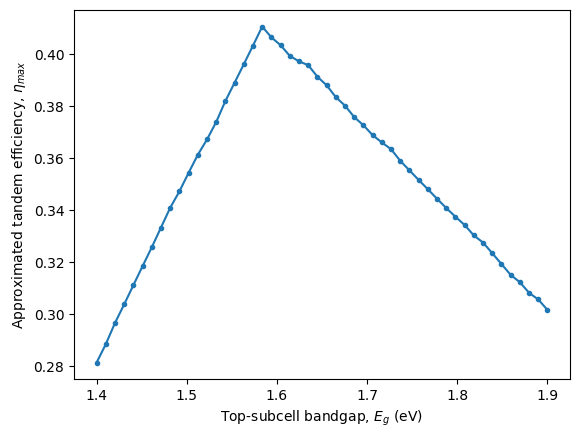Problem 6.6#
Fundamentals of Solar Cells and Photovoltaic Systems Engineering
Solutions Manual - Chapter 6
Problem 6.6
A research group with capabilities of III-V materials manufacturing wants to make a two-terminal tandem cell using an optimized composition with a bandgap of 0.9 eV for the bottom subcell. For the top subcell, they can grow compounds with bandgaps in the range 1.4 to 1.9 eV. Which bandgap should they use to achieve the maximum efficiency under the AM1.5G spectrum? Assume \(P_{max} \approx 0.85 · J · V_{max}\) as a rough estimation for the maximum power produced by each subcell. Here, the factor 0.85 approximates the fill factor of each subcell. \(J\) is the subcell’s photocurrent density and \(V_{max} \approx 0.75 · E_g\) (in volts) is an approximated value of the open-circuit voltage.
We will use the package pandas to handle the data and matplotlib.pyplot to plot the results
import pandas as pd
import numpy as np
import matplotlib.pyplot as plt
We start by importing the data
datafile = pd.read_csv('data/Reference_spectrum_ASTM-G173-03.csv', index_col=0, header=0)
datafile
| AM0 | AM1.5G | AM1.5D | |
|---|---|---|---|
| Wvlgth nm | Etr W*m-2*nm-1 | Global tilt W*m-2*nm-1 | Direct+circumsolar W*m-2*nm-1 |
| 280 | 8.20E-02 | 4.73E-23 | 2.54E-26 |
| 280.5 | 9.90E-02 | 1.23E-21 | 1.09E-24 |
| 281 | 1.50E-01 | 5.69E-21 | 6.13E-24 |
| 281.5 | 2.12E-01 | 1.57E-19 | 2.75E-22 |
| ... | ... | ... | ... |
| 3980 | 8.84E-03 | 7.39E-03 | 7.40E-03 |
| 3985 | 8.80E-03 | 7.43E-03 | 7.45E-03 |
| 3990 | 8.78E-03 | 7.37E-03 | 7.39E-03 |
| 3995 | 8.70E-03 | 7.21E-03 | 7.23E-03 |
| 4000 | 8.68E-03 | 7.10E-03 | 7.12E-03 |
2003 rows × 3 columns
datafile.drop(datafile.index[0], inplace=True) #remove row including information on units
datafile=datafile.astype(float) #convert values to float for easy operation
datafile.index=datafile.index.astype(float) #convert indexes to float for easy operation
We select the AM1.5G spectrum for our calculations
G = datafile['AM1.5G']
G
280.0 4.730000e-23
280.5 1.230000e-21
281.0 5.690000e-21
281.5 1.570000e-19
282.0 1.190000e-18
...
3980.0 7.390000e-03
3985.0 7.430000e-03
3990.0 7.370000e-03
3995.0 7.210000e-03
4000.0 7.100000e-03
Name: AM1.5G, Length: 2002, dtype: float64
First we define a function that calculates the power density produced by a subcell
def power_subcell(J,Eg): #J in A/m2, Eg in eV
return 0.85*J*0.75*Eg #W/m2
We define a function to calculate the maximum photocurrent that a subcell can deliver under the AM1.5G spectrum. The top cell will absorb all photons with more energy than its bandgap, whereas the bottom cell will only absorb photons more energetic than its bandgap but less energetic than the bandgap of the top cell.
We define the adequate constants to calcutale the ideal SR and, with it, we calculate the maximum current density \(J_{max}\) using Eq. 3.5
\(J_{max}=\int SR_{ideal}(\lambda) \cdot G(\lambda) \ d\lambda\) (A/m2)
h=6.63*10**(-34) # [J·s] Planck constant
e=1.60*10**(-19) #[C] electron charge
c =299792458 #[m/s] Light speed
idealSR=pd.Series(index=G.index,
data=[wl*0.000000001*e/(h*c) for wl in G.index])
def max_photocurrent(wl): #wl in nm
return np.trapz(G[G.index<wl]*idealSR[idealSR.index<wl], x = G.index[G.index < wl]) #A/m2
The power density produced by the two-terminal tandem is the sum of that of the two subcells. Since the subcells are series connectesd, the current density used in the calculation of the power density is the same for both subcells, and is the one of the subcell that generates less current.
def power_tandem(Eg_top, Eg_bot):
J_top_max=max_photocurrent(1240/Eg_top) #the bandgap is expressed in nm in the 'photocurrent' function
J_bot_max=max_photocurrent(1240/Eg_bot)-J_top_max #the bandgap is expressed in nm in the 'photocurrent' function
J_tandem=np.min([J_bot_max, J_top_max])
return power_subcell(J_tandem, Eg_top) + power_subcell(J_tandem, Eg_bot)
We define an array with the bandgap values to explore
gaps=np.linspace(1.4, 1.9, 50) #100 values
We construct an tandem-efficiency array using the ‘power_tandem’ function. The bandgap of the bottom cell is 0.9 eV.
P_in=1000 #W/m2, power density of the AM1.5G spectrum
tandem_effs = np.zeros(gaps.size)
for i, gap in enumerate(gaps):
tandem_effs[i]=power_tandem(gap, 0.9)/P_in
/tmp/ipykernel_2860/3351722810.py:9: DeprecationWarning: `trapz` is deprecated. Use `trapezoid` instead, or one of the numerical integration functions in `scipy.integrate`.
return np.trapz(G[G.index<wl]*idealSR[idealSR.index<wl], x = G.index[G.index < wl]) #A/m2
We plot the obtained efficiency as a function of the top-cell bandgap
plt.plot (gaps, tandem_effs, '.-')
plt.ylabel(r'Approximated tandem efficiency, $\eta_{max}$')
plt.xlabel(r'Top-subcell bandgap, $E_g$ (eV)')
Text(0.5, 0, 'Top-subcell bandgap, $E_g$ (eV)')

The approximated tandem efficiency is maximum for a top-subcell bandgap of around 1.6 eV.

